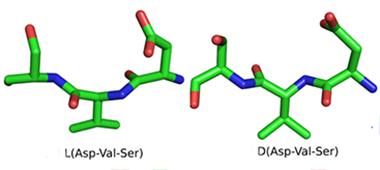D-peptides as Drugs? Protein Therapy Approaching Phase 1 Trials
Quick Links
An unusual, oligomer-morphing peptide therapy may soon graduate from preclinical studies into human trials for Alzheimer’s disease. Comprising D-amino acids, the peptides resist digestion by proteases that would make quick work of their chiral doppelgangers, the naturally occurring L-enantiomers. Over the past seven years, researchers led by Dieter Willbold at Forschungszentrum Jülich in Germany have been reporting that a D peptide called D3 converts Aβ oligomers into larger non-amyloidogenic species, reduces plaques in mouse brain, and improves cognitive function in several AD models. At the 12th International Conference on Alzheimer’s and Parkinson’s diseases, held March 18 to 22 in Nice, France, researchers from Willbold’s group presented new data on better-performing D3 derivatives that, like the original peptide, enter the brain efficiently when fed to mice. Barring unforeseen problems in ongoing toxicology and pharmacokinetic studies, Willbold said a D peptide is slated to enter human trials in 2016.

Sample peptide in the standard L form and its D mirror image.
Because D-enantiomers resist digestion in the stomach and are only weakly immunogenic, they are candidates for oral protein-based therapies. In 2008, Willbold and colleagues used a novel technique called mirror image phage display to find D3—a D-amino acid dodecamer that bound to Aβ fibrils. The scientists have since characterized it further (see van Groen et al., 2008; Aug 2009 conference story; Funke et al., 2010; and van Groen et al., 2012).
With their sights set on clinical development, the Willbold group synthesized D3 derivatives and tested them in vitro and in mice. These are the results they presented in Nice. In a talk and poster, respectively, his colleagues Oleksandr Brener and Tina Dunkelmann reported that one new compound, called C-1, targeted Aβ oligomers more efficiently than D3. The researchers added C-1 to a mixture of monomers, oligomers, fibrils, and larger species of Aβ, used density gradient centrifugation, and found that the oligomers disappeared while amounts of the larger fractions increased. Willbold said that the larger species formed in place of the oligomers did not go on to aggregate.
With collaborators Inga Kadish and Thomas van Groen from the University of Alabama at Birmingham, the researchers then compared the compounds head-to-head in two mouse models. After four weeks of intraperitoneal infusion with a minipump, both D3 and C-1 similarly boosted performance on the novel-object recognition test in the APPSweDI mouse model compared to untreated mice. TBA2 mice, which express a pyroglutamate Aβ peptide and develop motor and cognitive deficits, maintained their ability to balance on a spinning rod after one month’s treatment with either peptide, while C-1 preserved neural reflexes better than D3 did. Willbold told Alzforum that, to his mind, these experiments suggest that the peptides spare motor neurons from degeneration in this model. “The new derivatives work in some regards better, and in all regards at least as well as D3,” Willbold said. Other derivatives also outperformed the original D3, as presented on posters by Tamar Ziehm and Antonia Klein of Forschungszentrum Jülich.
The researchers next investigated the pharmacokinetic profile of D3 and its derivatives. They labeled D3 with radioactive tritium and delivered it into mice via several routes orally, intravenously, or by injecting it into the abdominal cavity. As presented on a poster by Nan Jiang, D3 had at least a 24-hour half-life in plasma, which is excellent compared to the hour-long half-life of typical L-peptides, Willbold said. The peptide easily passed the blood-brain barrier. Leonie Leithold’s poster reported that the derivatives of D3 had similar pharmacokinetics. Both Jiang and Leithold also work with Willbold.
“The derivatives of D3 are promising because of their direct interaction with Aβ oligomers. The bottom line is that at least in the transgenic mouse models, they have reproducible and promising effects,” commented Manfred Windisch of NeuroScios in Graz, Austria. He was not involved in the studies but has worked with D3 in the past.
The scientists are now completing preclinical toxicology and safety studies. Willbold said he has secured funding from the Helmholtz Validation Fund to initiate a Phase 1 trial. He would not reveal which D3 derivative has been picked, but expects the trial to start in 2016.—Jessica Shugart
References
News Citations
Research Models Citations
Paper Citations
- van Groen T, Wiesehan K, Funke SA, Kadish I, Nagel-Steger L, Willbold D. Reduction of Alzheimer's disease amyloid plaque load in transgenic mice by D3, A D-enantiomeric peptide identified by mirror image phage display. ChemMedChem. 2008 Dec;3(12):1848-52. PubMed.
- Aileen Funke S, van Groen T, Kadish I, Bartnik D, Nagel-Steger L, Brener O, Sehl T, Batra-Safferling R, Moriscot C, Schoehn G, Horn AH, Müller-Schiffmann A, Korth C, Sticht H, Willbold D. Oral treatment with the d-enantiomeric peptide D3 improves the pathology and behavior of Alzheimer's Disease transgenic mice. ACS Chem Neurosci. 2010 Sep 15;1(9):639-48. Epub 2010 Aug 2 PubMed.
- van Groen T, Kadish I, Funke A, Bartnik D, Willbold D. Treatment with Aβ42 binding D-amino acid peptides reduce amyloid deposition and inflammation in APP/PS1 double transgenic mice. Adv Protein Chem Struct Biol. 2012;88:133-52. PubMed.
External Citations
Further Reading
No Available Further Reading
Annotate
To make an annotation you must Login or Register.

Comments
No Available Comments
Make a Comment
To make a comment you must login or register.